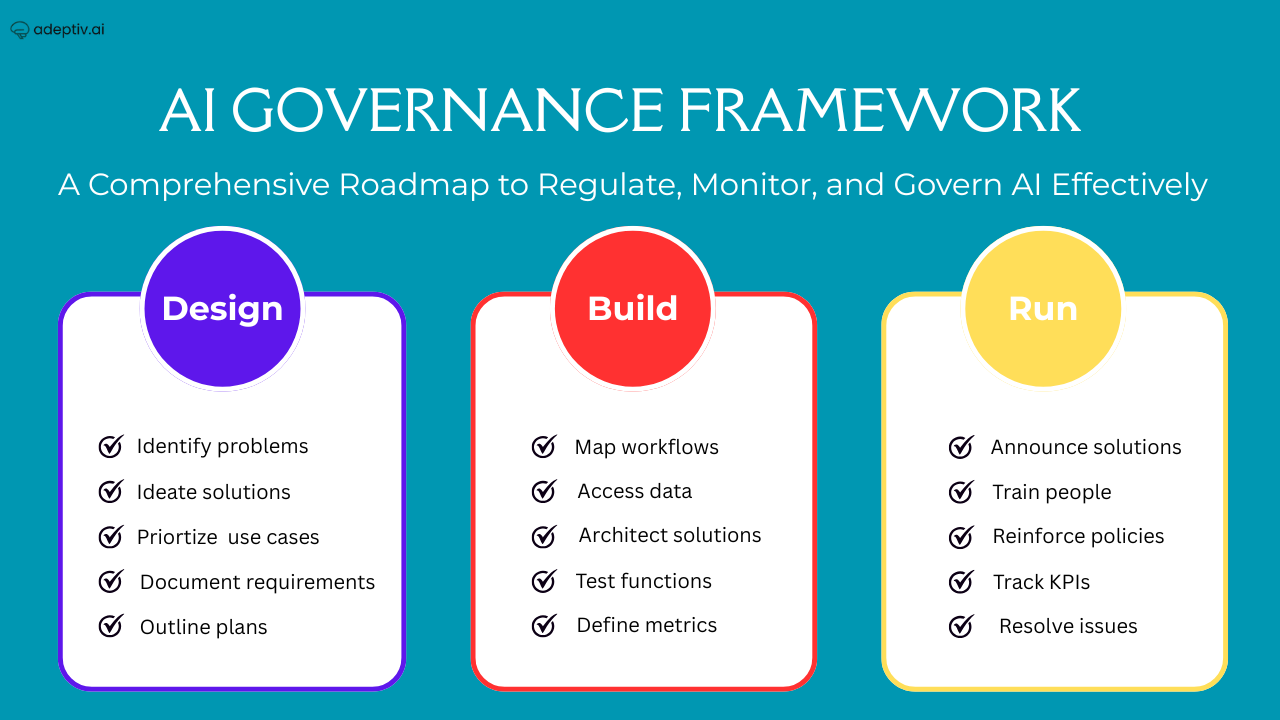At a Glance
- An AI-ready data layer enables trustworthy, scalable AI by ensuring data is reliable, observable, and governed end-to-end.
- Data catalogs act as the central metadata hub, improving data discovery, ownership clarity, and semantic consistency across teams.
- Data lineage delivers full traceability—from data origin to model outputs—supporting compliance, debugging, and impact analysis.
- Data quality controls monitor accuracy, freshness, completeness, and drift to prevent silent model degradation in production.
- Integrating catalogs, lineage, and quality with feature stores and model registries ensures reproducibility and consistent model performance.
- A structured adoption approach—pilot → scale → govern—helps organizations accelerate AI deployment while reducing risk and compliance burdens.
Why the Data Layer Matters
AI models are only as good as the data they consume. Fragmented metadata, opaque lineage and inconsistent quality create bias, hidden drift, and costly rework. Leading data and governance platforms emphasize cataloging, observability and integrated governance as foundational for AI initiatives.
Pillar 1 — Data Catalogs: Discover, Describe, and Govern
A modern data catalog is the single pane for metadata: schemas, semantic business glossaries, data owners, sensitivity tags, sample data and lineage references. It accelerates discovery for data scientists and enforces access controls for privacy teams.
Practical steps
- Inventory all data assets (structured, semi-structured, unstructured) and assign business owners.
- Implement automated metadata harvesting (connectors to lakehouses, warehouses, SaaS apps) and combine with manual curation for semantic context.
- Build a business glossary and map technical terms to business concepts (customer, account, transaction).
- Surface quality metrics and usage signals in catalogue entries to rank trustworthy assets.
Catalogues reduce time-to-insight and provide the discovery substrate for feature stores and model registries.
Pillar 2 — Lineage: Provenance, Impact and Auditability
Lineage links data producers to downstream models, reports and dashboards. For AI readiness, lineage must be end-to-end, automated and queryable.
Requirements:
- Capture physical lineage (job runs, transformations), logical lineage (business rules) and model lineage (features to model versions).
- Record transformation metadata: who ran it, when, with what code and parameters.
- Enable impact analysis queries (“If I change this table, which models are affected?”) so teams can prioritize validation and rollout.
Lineage is indispensable for debugging, root cause analysis and compliance reporting under emerging AI regulations.
Pillar 3 — Data Quality: Validate, Monitor, Remediate
Quality for AI goes beyond null counts and schema checks. It must include statistical validation, distribution checks, labeling quality and semantic correctness.
Operational practices:
- Define quality SLAs per dataset and feature (completeness, uniqueness, freshness, label accuracy).
- Implement automated checks at ingestion, transformation and serving stages — block bad data from entering feature stores.
- Monitor production for data drift (feature distributions), label drift, concept drift and inference-time anomalies.
- Connect quality alerts to remediation playbooks and service tickets for fast resolution.
Observability across pipelines reduces model decay and business risk.
Architecture & Integration Patterns
Design an architecture that separates concerns while enabling tight feedback loops:
- Metadata layer (catalog + lineage store) that indexes assets and events.
- Data layer (lakehouse / warehouse) for raw and curated datasets.
- Feature store for serving consistent, versioned features to training and inference.
- Model registry and monitoring that link models to feature versions and data quality metrics.
Use event streaming and policy engines to propagate changes and enforce validations in near-real-time.
Governance, Security and Privacy
Embed governance into the data lifecycle:
- Tag sensitive fields and enforce purpose-based access controls and masking.
- Automate audit trails and produce DPIA artifacts for high-risk AI systems.
- Adopt policy-as-code for enforcement and use catalog metadata to map policies to assets.
This alignment between catalog, lineage and quality ensures privacy teams can certify models while data teams maintain agility.
Operational Playbook
- Kickoff: inventory assets, appoint data stewards and define KPIs (model accuracy, feature freshness).
- Pilot: onboard 1–2 critical datasets into catalog + lineage and implement quality checks.
- Iterate: expand to the top 20% of assets that deliver 80% of model value; automate harvesting and alerts.
- Scale: integrate feature store and model registry; enforce CI/CD for data and model changes.
- Govern: publish runbooks, SLA dashboards and quarterly audits tying model performance to data quality metrics.
KPIs and Measurable Outcomes
Track these KPIs to prove impact:
- Mean time to root cause for incidents (target: reduce by 50% within 6 months).
- % of production features with lineage and quality SLA (target: 95%).
- Reduction in model rollback rate due to data issues (target: >60% reduction).
Tools & Vendor Considerations
Select tools that prioritise metadata interoperability (OpenMetadata, Apache Atlas, native catalogue features in cloud providers) and support automated lineage capture. Favour solutions offering:
- Rich connectors to your data estate.
- APIs and policy engines for automation.
- Tight integrations with feature stores, model registries and observability platforms.
Proof of value often comes from integrating catalogue lineage with a single high-impact ML workflow first.
Advanced Practices and Standards
Adopt explicit data contracts between producers and consumers to formalize expectations about schema, SLAs and semantic meaning. Use versioned contracts alongside CI pipelines so breaking changes fail builds rather than silently degrading models. Standardize on metadata models and open lineage schemas to enable interoperability and reduce integration overhead.
Testing, CI/CD and Release Management for Data
Treat data changes like code changes. Implement data unit tests, schema checks and canary releases for datasets. Integrate data validations into CI pipelines and gate deployments to production with policy checks from the metadata layer. Use canary evaluation windows to compare model metrics when new feature versions or datasets are introduced.
Change Management and Roles
Successful programs assign clear roles: data stewards (business semantics), data engineers (pipeline reliability), ML engineers (feature versioning) and privacy officers (sensitivity & controls). Create a cross-functional governance board to prioritize asset onboarding and resolve policy conflicts. Regular training and a documented playbook accelerate adoption.
Prioritization Framework
Not all assets should be catalogued first. Prioritize datasets that:
- Feed production models or BI dashboards with direct business impact.
- Have high access frequency or are reused across teams.
- Contain sensitive data or have regulatory implications.
A focused 20% of datasets typically accounts for 80% of model performance impact — start there, automate, and scale out.
Checklist
Below is the set of non-negotiable capabilities required to ensure your data layer is truly AI-ready. Each element directly supports model reliability, governance, and scalability.
| Checklist | Requirement | Explanation |
| ✅ | Inventory Complete | All enterprise data assets—structured and unstructured—are indexed and recorded, eliminating blind spots and duplicated data sources. |
| ✅ | Automated Metadata Harvesting | Metadata is continuously extracted from pipelines, tables, APIs, and applications to keep data context accurate without manual effort. |
| ✅ | Business Glossary Published | Key data terms and definitions are standardized and mapped to data assets, ensuring semantic alignment across business and technical teams. |
| ✅ | End-to-End Lineage Captured | Full visibility into where data originates, how it transforms, and where it is consumed—critical for debugging, governance, and traceability. |
| ✅ | Quality SLAs Defined | Data quality thresholds (freshness, accuracy, completeness, consistency) are explicitly measured and enforced at ingestion and transformation points. |
| ✅ | Drift Monitoring Enabled | Continuous checks detect schema shifts, data distribution drift, and operational anomalies to prevent silent dataset degradation over time. |
| ✅ | Feature Store Integrated | Machine learning features are centrally governed, versioned, and reusable across teams to avoid redundancy and inconsistent model behavior. |
| ✅ | Model–Data Linkage in Registry | Every model version is linked to the exact dataset, features, and lineage used during training, enabling auditability and reproducibility. |
| ✅ | Access Controls + Masking | Role-based permissions, tokenization, encryption, and dynamic masking ensure secure, compliant data access across environments. |
| ✅ | Quarterly Audit Process | A recurring governance and validation cycle confirms that data lineage, metadata, SLAs, and access controls remain accurate and enforced as systems evolve. |
Conclusion
An AI-ready data layer is the combination of discoverable metadata, traceable lineage and measurable quality. Building it requires clear governance, incremental pilots and cross-functional ownership. When catalog, lineage and quality are implemented as a cohesive platform, organizations can reduce risk, boost model performance and scale AI with confidence.
FAQs
1. What is an AI-ready data layer?
An AI-ready data layer is a governed data foundation that ensures metadata visibility, lineage traceability, and continuous data quality monitoring across pipelines to support reliable model development and deployment.
2. Why do data catalogs matter for AI?
Data catalogs centralize metadata, business definitions, ownership, and access controls, making it easier for teams to discover and trust the datasets used to train and operate AI models.
3. How does data lineage support compliance?
Lineage shows where data comes from, how it changes, and which models depend on it. This is crucial for audits, model transparency, regulatory reporting, and safe system updates.
4. What data quality metrics are most important for machine learning?
Freshness, completeness, uniqueness, label accuracy, and distribution stability are key for preventing model drift, performance degradation, and unexpected prediction errors.
5. When should an organization introduce a feature store?
A feature store should be introduced once multiple models share common features. It ensures version control, reusability, and consistency across training and inference environments.



